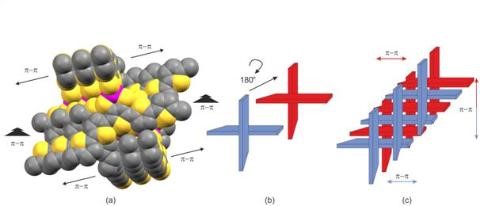So far these notes on heterocyclic chemistry have dealt mostly with applications in medicinal chemistry. However one of the key things about heterocyclic chemistry is the range of applications that it supports. I was once involved in a project involving conducting polymers as biosensors with a former colleague at Strathclyde but rather than go back to old and only partially successful work, it is better to talk to a current colleague, Professor Peter Skabara, who is an expert in molecular materials and involved in cutting edge research.
Professor Peter Skabara
Pete, molecular materials and their applications are a big step from drugs so could you say a little about the field and its importance?
…Molecular and polymer materials are associated with a broad range of applications but semiconductors are the ones that fascinate me the most. Whereas inorganic semiconductors are well established and of exceptional value to society and industry (e.g. silicon based chips, low power solid state lighting), the versatility of organic chemistry allows the characteristics of organic or ‘plastic’ semiconductors to be tuned in terms of properties and functionality, allowing them to be applied in more sophisticated, multi-purpose applications. Tuning of organic materials is achieved through structural design at the molecular level and that’s something inorganic bulk semiconductors lack. The field of plastic electronics is new and promises cheap and easily adaptable devices. Potential applications are far-reaching and include biocompatible sensors, printable solar cells and ultra-efficient large panel lighting, whereas organic light emitting diodes (OLEDs) are already commercialised in the display market in large OLED TVs and Samsung Galaxy smartphones.
I’ve explained to readers why heterocyclic compounds have such a big impact in drug discovery in terms of tuning of properties and molecular association. Is there something in your field that makes heterocyclic compounds particularly appropriate for development?
…The use of heterocyclic units in organic semiconductors is necessary to create semiconductors with a wide range of electronic properties. This is important for several reasons. For example, in photonics applications in which the organic semiconductor is used as an emitter of visible light, the energy of the band gap is directly related to the colour of light produced by the material. Without the use of heterocyclic units organic semiconductors would be limited to carbon-only conjugated backbones giving blue light only. Heterocyclic units provide reliable building blocks for the design of molecular and polymer semiconductors with targeted properties.
I wonder what the biggest challenges are. Are they designing compounds, synthesis, or perhaps the robustness of the compounds themselves for applications?
…From a holistic viewpoint, improving the overall performance and efficiency of plastic electronic devices will always be the main driver, but achieving this requires a series of individual materials with specific properties. There are many properties that need optimising for any given material; these include the film forming ability, targeted electronic properties, thermal stability and environmental stability under device operating conditions. The cost has to be kept down too. Ultimately, the chemist is left feeling like a circus juggler trying to keep all the balls up in the air, knowing that one change in design may be good for one attribute but detrimental to another. This is typical of the challenges that many applied synthetic chemists face, but it’s also the thing that keeps us motivated and interested!
So where are molecular materials making a practical impact now?
…There are many exciting emerging applications, such as printable solar cells, ultra-low power lighting, plastic lasers the size of postage stamps and LiFi – a fascinating alternative to WiFi technology that works on room lighting instead of radio waves! Already on the market are Samsung, LG, Panasonic and Sony OLED display products in TVs and smartphones, and there are numerous spin-out companies working on products such as explosives sensors, topical cancer treatment and printable batteries. The future of plastic electronics has huge potential benefits –experts have predicted that organic light emitting diodes alone will represent a $12 billion industry by 2020.
What about your own compounds, Pete. Do you have a favourite … or is there one that is special for what it can do?
…The most exciting type of material being made in my group is the so-called ‘star-shaped’ family of conjugated compounds. These materials are a challenge to make, but they can be prepared in gram quantities. They combine the desirable attributes of molecular based systems and polymers, such as high purity, sharp electronic characteristics, thermal stability, excellent film-forming properties and high degrees of solubility. They have been applied as light emitters in plastic lasers with some record-breaking achievements, in devices for LiFi technology and in solar cells.
The structure and assembly of some of Pete Skabara’s record-breaking compounds.










